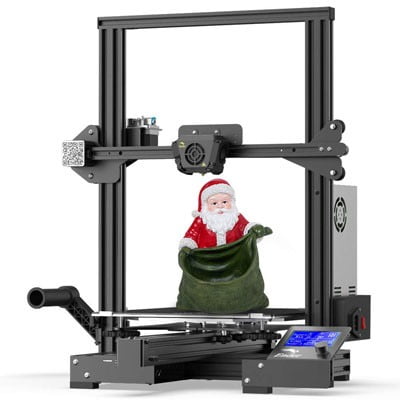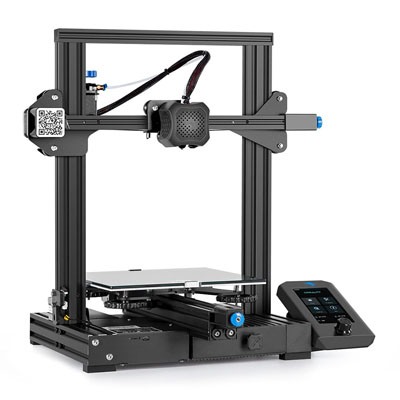Creality offers two desktop 3D printer kits, the Ender 3 Max and the Ender 3 V2. Both printers offer a lot of great features, but we will be comparing them based on build volume, filament run-out sensors, and upgradability. We will weigh our recommendation on user skill level as well as project needs as these are the most important factors that tie into selecting either the Ender 3 Max or the Ender 3 V2.
Creality Ender 3 Max
Offering a large build volume, the Ender 3 Max stands out as an open-frame 3D printer for larger projects. It features a large glass print bed, an extra radial fan, and customization options.
The Ender 3 Max offers a build volume of 300 x 300 x 340 mm. This larger build volume allows for the printing of larger pieces without the need to split them.
It sports a carborundum glass print surface. This glass offers great adhesion as it is heat resistant. It is very easy to remove models once the printing finishes.
The Ender 3 Max comes equipped with a TMC2208 silent driver. This eliminates the noise the stepper motors make to allow for silent printing.
The print head has an extra radial fan. This fan improves cooling, making it more consistent and providing better bridging and overhang performance. The Ender Max 3 also has a highly resistant hot end. With this hot end, there is no delay with the melting of filaments.
The Ender Max 3 features manual bed leveling. However, users have the option to install a BLTouch sensor to the unit. This sensor will upgrade the printer to have automatic bed leveling.
This printer features a single-gear metallic extruder. There is also a filament run-out sensor. This sensor will pause printing when the filament runs out. However, users will need to be nearby the printer when this happens as the printer will turn off all the heaters while waiting for filament replacement. This means that the print may become detached from the print bed.
The printer also offers an auto-resume function. If something goes wrong, your printing will restart right where it left off.
The Ender Max 3, as a downside, only offers one Z screw with an anti-backlash nut. A single screw will lead to a droop on the right side of the X gantry, causing problems with leveling accuracy and the first layer of the print.
The printer comes equipped with a 12864 screen that is compatible with most firmware. It is not a touchscreen.
Creality Ender 3 V2
Like the Ender 3 Max, the Ender 3 V2 offers a Bowden extruder that feeds a single hot end and manual bed leveling. The UI on both units is not a touchscreen and is controlled by a knob. The Ender 3 V2 also features the use of the TMC2208 chip that dampens printing noise to less than audible levels.
Unlike the Ender 3 Max, the Ender 3 V2 only offers a build volume of 220 x 220 x 250.
Users complete print bed leveling using the paper method. However, the printer can be upgraded with the BLTouch or CRTouch sensor to enable automatic bed leveling.
The Ender 3 V2 features a storage drawer. This drawer is unique to this printer.
This printer also features a silicone sock over the heater. This protects the nozzle from stray filament strands and loose prints.
The Ender 3 V2 has an XY-axis tensioner. The printer has two knobs that will allow users to tighten the belts. This will be beneficial as the printer ages.
Also, the printer features an auto-resume function. Any power outage or accidental cut-off will not be a problem. Once power is restored, the printing will resume where it left off. However, the Ender 3 V2 does not feature a filament sensor, making things more difficult when filaments begin to run low.
Our Recommendation
While both printers offer a wide variety of excellent features, we must delineate the differences between the two before users commit to purchasing one of them. With its large build volume, filament run-out sensor, and auto-resume function, the Ender 3 Max is very easy to use. We recommend it for entry-level printers as well as more advanced printers who would be interested in customizing the unit.
On the other hand, the Ender 3 V2 offers a smaller print bed and no filament run-out sensor. It is a basic 3D printer that is best for entry-level printers.

